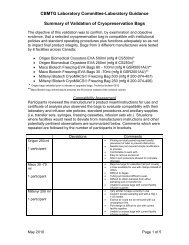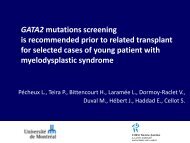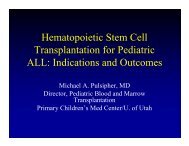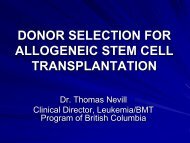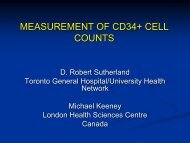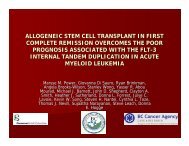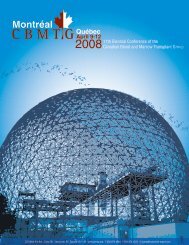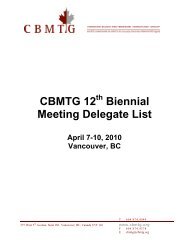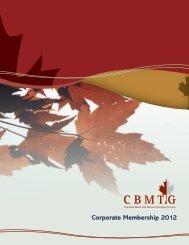A Randomized Trial of Thymoglobulin to Prevent Chronic ... - CBMTG
A Randomized Trial of Thymoglobulin to Prevent Chronic ... - CBMTG
A Randomized Trial of Thymoglobulin to Prevent Chronic ... - CBMTG
Create successful ePaper yourself
Turn your PDF publications into a flip-book with our unique Google optimized e-Paper software.
A <strong>Randomized</strong> <strong>Trial</strong> <strong>of</strong> <strong>Thymoglobulin</strong><strong>to</strong> <strong>Prevent</strong> <strong>Chronic</strong> Graft versus Host Diseasein Patients Undergoing Hema<strong>to</strong>poietic Progeni<strong>to</strong>r CellTransplantation (HPCT) from Unrelated Donors.Study <strong>CBMTG</strong>-0801Study <strong>CBMTG</strong>-0801
Appendix AIllustrations <strong>of</strong> cGVHD – Joints and LungJointRestrictions<strong>Chronic</strong> lung disease
Appendix AIllustrations <strong>of</strong> cGVHD - Oral
Appendix AIllustrations <strong>of</strong> cGVHD- Derma<strong>to</strong>logical
Quality <strong>of</strong> LifeFraser CJ et al. Impact <strong>of</strong> chronic graft-versus-host disease on the health status <strong>of</strong>hema<strong>to</strong>poietic cell transplantation survivors: a report from the Bone Marrow TransplantSurvivor Study. Blood 2006;108:2867-2873.
FinkeLancet Oncol 2009;10: 855–64BacigalupoBlood 2001;98:2942BBMT 2006;12:560ATG-Fresenius60 mg/kg <strong>to</strong>tal<strong>Thymoglobulin</strong>Low-dose7.5 mg/kg <strong>to</strong>tal<strong>Thymoglobulin</strong>High-dose15 mg/kg <strong>to</strong>talPrimary End-Point Death/AGVHD III-IV AGVHD III-IVPrimary End-Point NS NS 11% vs 50%, P=.001Infectious Deaths NS NS 30% vs 7%Survival NS NS NSNon RelapseMortality<strong>Chronic</strong> GVHD 30.8% vs 58.8%p
A <strong>Randomized</strong> <strong>Trial</strong> <strong>of</strong> <strong>Thymoglobulin</strong><strong>to</strong> <strong>Prevent</strong> <strong>Chronic</strong> Graft versus Host Diseasein Patients Undergoing Hema<strong>to</strong>poietic Progeni<strong>to</strong>r CellTransplantation (HPCT) from Unrelated Donors.Study <strong>CBMTG</strong>-0801Study <strong>CBMTG</strong>-0801
Administration0801 <strong>Trial</strong> Committee• Stephen Couban• Ronan Foley• Stephanie Lee• Tony Panzarella• Jean Roy• Kirk Schultz• David Schweitzer• Chris<strong>to</strong>pher Skedgel• Cynthia Toze• Holly Kerr• Irwin WalkerCollaboration• Paul MartinCoordinationUniversity <strong>of</strong> British Columbia• Clay Smith• Holly KerrData Safety Moni<strong>to</strong>ringCommittee (DSMC)• Pediatric BMT Consortium
FundingTOTAL GRANT:CIHR:$1,245,055 (CAD)Genzyme Corporation: $800,000 (US)Total $2,045,055
HypothesisThe addition <strong>of</strong> <strong>Thymoglobulin</strong>® <strong>to</strong> the preparative regimen willresult in a decrease in the proportion† <strong>of</strong> patients with chronicgraft versus host disease, resulting in improved quality <strong>of</strong> life butwithout an increase in mortality, disease relapse or death due <strong>to</strong>infection.† from 0.6 <strong>to</strong> 0.4
FinkeLancet Oncol 2009;10: 855–64BacigalupoBlood 2001;98:2942BBMT 2006;12:560ATG-Fresenius60 mg/kg <strong>to</strong>tal<strong>Thymoglobulin</strong>Low-dose7.5 mg/kg <strong>to</strong>tal<strong>Thymoglobulin</strong>High-dose15 mg/kg <strong>to</strong>talPrimary End-Point Death/AGVHD III-IV AGVHD III-IVPrimary End-Point NS NS 11% vs 50%, P=.001Infectious Deaths NS NS 30% vs 7%Survival NS NS NSNon RelapseMortality<strong>Chronic</strong> GVHD 30.8% vs 58.8%p
The Primary EndpointFreedom <strong>of</strong> chronic graft versus host disease at 12 months fromtransplantation defined as withdrawal <strong>of</strong> all systemicimmunosuppressive agents without resumption up <strong>to</strong> 12 monthsafter transplantation (this end-point is binary i.e. Yes/No).
Time <strong>to</strong> Onset <strong>of</strong> Prednisone RxMielkarek et al. Blood 2003;102:756-762
Sample Size198 Patients• To demonstrate absolute 20% decrease in need for treatment(60% <strong>to</strong> 40%).• Allowing for 2% drop out• Half will receive <strong>Thymoglobulin</strong>
Secondary End-Points• Time <strong>to</strong> engraftment• Incidence <strong>of</strong> acute GVHD• Incidence <strong>of</strong> chronic GVHD according <strong>to</strong> NIH Consensus criteria• Incidence <strong>of</strong> chronic GVHD according <strong>to</strong> Sullivan Criteria• Time <strong>to</strong> non-relapse mortality• Time <strong>to</strong> all-cause mortality• Time <strong>to</strong> relapse <strong>of</strong> leukemia• Incidence <strong>of</strong> Graft rejection or failure• Incidence <strong>of</strong> Serious infection• Incidence <strong>of</strong> CMV activation• Quality <strong>of</strong> life• Cost effectiveness• Incidence <strong>of</strong> specific organ grades (NIH) <strong>of</strong> chronic graft versus host disease• Number <strong>of</strong> months on immunosuppression up <strong>to</strong> 12 months post transplant• Proportion <strong>of</strong> patients needing immunosuppression at 24 months• Doses <strong>of</strong> immunosuppressive drugs at 12 months• Immunosuppressive therapy at time <strong>of</strong> diagnosis <strong>of</strong> cGVHD
Inclusion Criteria1. The recipient is aged between 16 and 702. The recipient has an hema<strong>to</strong>logic malignancy3. The recipient will receive either a bone marrow (“HPC, Marrow”) orblood progeni<strong>to</strong>r cell (“HPC, Apheresis”) graft4. The preparative regimen may be MAbl, NMAbl, or RIC5. The recipient has an unrelated donor who with high resolution typing iseither fully MHC matched at HLA-A, B, C and DRB1 with the recipient oris 1-antigen or 1–allele mismatched at A, B, C or DRB1 loci
Treatment Plan - <strong>Thymoglobulin</strong>The experimental intervention is the addition <strong>of</strong> <strong>Thymoglobulin</strong><strong>to</strong> the standard preparative regimen.The <strong>to</strong>tal dose <strong>of</strong> <strong>Thymoglobulin</strong> is 4.5 mg/kg (actual bodyweight, not effective body weight), given in divided doses asfollows:Day -2: 0.5 mg/kgDay -1: 2.0 mg/kgDay 0: 2.0 mg/kgDayDayDayDayDayDayDayDay–7–6–5–4–3–2–10 ¤Preparative Regimen(Arms A and B)Myeloablative or non-myeloablative (syn.RIC*)conditioning regimen†GraftInfusion<strong>Thymoglobulin</strong>0.52.02.0(Arm B only)mg/kgmg/kgmg/kg
Treatment Plan – PreparativeRegimensMYELOABLATIVE• CY-TBI• BUCY• BUFLUNON-MYELOABLATIVE (syn. RIC)• BUFLU(ATG) - Slavin• FLU-TBI - Seattle• FLU-MELRegimens containing ATG or Campath not allowed
Flu-Bu-ATG (Slavin) vs F-TBI (Seattle)Tandem Meeting, Orlando, 20105-year overall survival: Flu-Bu-ATG 45%F-TBI 49%
Reviews <strong>of</strong> NM/RIC Regimens• Banna GL, Aversa S, Sileni VC, Favaret<strong>to</strong> A, Ghiot<strong>to</strong> C,Monfardini S. Nonmyeloablative allogeneic stem celltransplantation (NST) after truly nonmyeloablative andreduced intensity conditioning regimens. Critical Reviews inOncology-Hema<strong>to</strong>logy. 2004;51:171-189.2. Pollack SM, O'Connor TP,Jr, Hashash J, Tabbara IA.Nonmyeloablative and reduced-intensity conditioning forallogeneic hema<strong>to</strong>poietic stem cell transplantation: a clinicalreview. American Journal <strong>of</strong> Clinical Oncology. 2009;32:618-628.
Benefits and Harms• BENEFITS• Less chronic graft versus host disease• Improved quality <strong>of</strong> life• Lower health care costs• HARMS• {NO increase in mortality, disease relapse or deaths due <strong>to</strong>infection}• Post Transplant Lymphoproliferative Disorder (EBV)
Epstein Barr Virus (EBV)BACKGROUND1. Herpes virus type 4.2. Infects over 90% <strong>of</strong> worlds population, mostly unrecognized, or as IM.3. Latency, like other herpesviruses (HSV, HZV, CMV)4. Latent state in B-lymphocytes5. Highly immunogenic resulting in B-cell proliferation, occasionally malignant.6. Activation controlled by EBV-specific T-cells7. Activation can result in a spectrum <strong>of</strong> disorders collectively termed PostTransplant Lymphoproliferative Disorder (PTLD).8. Median time <strong>to</strong> document EBV activation by QPCR following HPCT is 60days (most
PTLD in Unrelated/Mismatch +ATGStudy Activation PTLD DeathsWagner 29.4% 2/46 (4.3%) vs.6/39 (15%) TCDFinke N/A 5/103 (4.9%) vs.1/98 (1%) no ATGRussell (personalcommunication)0/23/6N/A 3/91 (3.3%) 0/3Bacigalupo 0% 0/53 (0%) 0Dominiet<strong>to</strong> 71% (19%>1000) 6/77 (8%) 2/6Deeg 2% (1/56) 0/66 0/0
Management <strong>of</strong> EBV• Be aware <strong>of</strong> the possibility; watch for FUO andlymphadenopathy.• Perform QPCR for EBV weekly until day 100• If QPCR shows activation, consider decreasingimmunosuppression.• If symp<strong>to</strong>ms are compatible:– Have a low threshold for imaging and biopsy– Exclude alternative diagnoses– Give rituximab weekly until symp<strong>to</strong>ms and copy number normalize.– Consider DLI if donor EBV antibody-positive.
Performance <strong>of</strong> QPCR test for EBVAssume prevalence <strong>of</strong> PTLD will be 3%PTLD YESPTLD NOTEST POS 3 60 PPV 3/63= 0.48%TEST NEG 0 40 NPV 40/(40+0)= 100%Sensitivity3/(3+0)= 100%Specificity40/(40+60)= 40%Rising titres adds specificity.Presence <strong>of</strong> EBV-specific CTL in blood improves specificity (To 100%?)
Shulman/Sullivan cf. NIHShulman/Sullivan• Time dependent ±100 days• Classification– Classic acute 100 days• Only Skin and Liver diagnostic• No patient centred parametersNIH• Manifestation dependent• Classifications:– Classic acute 100days– chronic any time– Overlap syndrome any time• Skin, lung, mouth, genitalia, GI,lungs, s<strong>of</strong>t tissues are diagnostic• Symp<strong>to</strong>ms and function added,description more detailed e.g.extent, ulceration
cGVHD Manifestions – NIHFilipovich BBMT 2005;11:945 and asbmt.orgFor each organ system manifestations are:• Diagnostic – sufficient <strong>to</strong> make a diagnosis• Distinctive – needs extra test, clinical, biopsy etc• Other – Rare, controversial, non-specific• Common (shared by both acute and chronic)Diagnostic process:• Presence <strong>of</strong> at least 1 Diagnostic OR 1 Distinctive + biopsy etc.• Distinguish from acute GVHD• Exclude other possible diagnoses
cGVHD Assessment by NIHFilipovich BBMT 2005;11:945-55 and asbmt.org• Diagnosis (Diagnostic/Distinctive)• Organ Scoring• Global Scoring• Performance Score (Function)– Walk time– Grip Strength– Karn<strong>of</strong>sky
cGVHD Case Report Form (CRF)
cGVHD Case Report Form (CRF)
cGVHD Case Report Form (CRF)
cGVHD Case Report Form (CRF)
Body Surface Area (Rule <strong>of</strong> 9)
Derma<strong>to</strong>logy Work Sheet
Will <strong>CBMTG</strong> 0801 succeed?In part for sure
FinkeLancet Oncol 2009;10: 855–64BacigalupoBlood 2001;98:2942BBMT 2006;12:560ATG-Fresenius60 mg/kg <strong>to</strong>tal<strong>Thymoglobulin</strong>Low-dose7.5 mg/kg <strong>to</strong>tal<strong>Thymoglobulin</strong>High-dose15 mg/kg <strong>to</strong>talPrimary End-Point Death/AGVHD III-IV AGVHD III-IVPrimary End-Point NS NS 11% vs 50%, P=.001Infectious Deaths NS NS 30% vs 7%Survival NS NS NSNon RelapseMortality<strong>Chronic</strong> GVHD 30.8% vs 58.8%p
Flowers ME, S<strong>to</strong>rer BE, Lee SJ, et al. Risk Fac<strong>to</strong>rs for the Development <strong>of</strong>Acute and National Institute <strong>of</strong> Health (NIH) <strong>Chronic</strong> Graft-Versus-Host Disease(GVHD). Blood. 2009;114 (abstr 345)
Will <strong>CBMTG</strong> 0801 succeed?In part for sureIn <strong>to</strong>tality - hopefullyWill the decrease in cGVHD have meaning for patientsi.e. less immunosuppression, better quality <strong>of</strong> life, andless medicalization…. and for the administra<strong>to</strong>rs: noextra cost (or maybe even cost savings)?
Thank you





